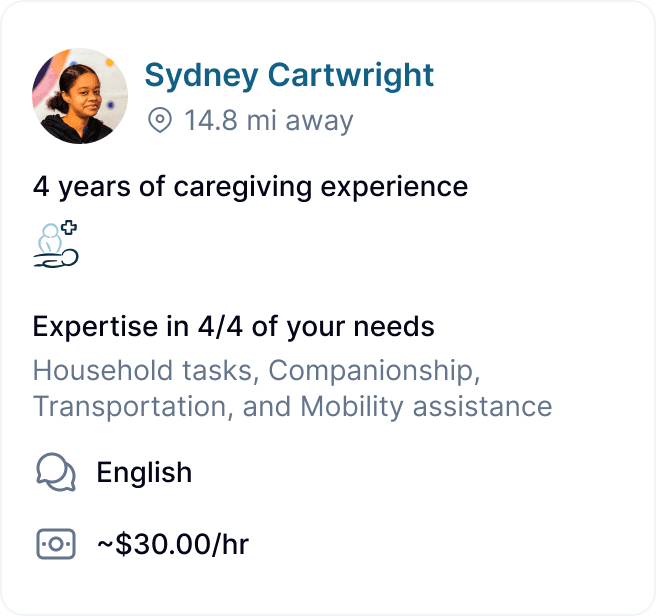Can My Mom Stay Living At Home?



Many adult children find themselves asking, “Can my mom stay living at home as she gets older?” The answer is often yes—but it requires thoughtful planning, open communication, and sometimes, a little extra support.
Aging in place—the term for staying in your own home as you grow older—is a goal for most seniors, who value their independence, comfort, and familiar surroundings.
This guide explores what aging in place means, its benefits, the challenges involved, and how families can make it a reality, with subtle references to how services like Clara Home Care can help.
What Is Aging in Place?
Aging in place refers to the ability to live in one’s own home and community safely, independently, and comfortably, regardless of age, income, or ability level. It’s about maintaining control over daily routines and making choices that suit individual needs and preferences.
For many older adults, staying at home means preserving a sense of identity and belonging. It allows them to remain close to family, friends, and the community they’ve built over a lifetime. The desire to age in place is deeply personal and deeply tied to emotional well-being and quality of life.
The Benefits of Aging in Place
Aging in place offers numerous advantages, both emotional and practical:
Maintaining Independence: Staying at home allows seniors to keep control over their daily lives, from what they eat to when they wake up and go to bed. This sense of autonomy is crucial for mental and emotional health.
Emotional and Psychological Well-Being: Being surrounded by familiar sights, sounds, and memories can reduce stress and anxiety. Independence fosters self-worth and dignity, which are essential for happiness and life satisfaction.
Financial Savings: Compared to the costs of assisted living or nursing homes, aging in place can be more affordable. Families only pay for the services they need, such as occasional help with housekeeping or personal care, rather than a bundled package of residential care.
Personalized Support: With in-home care options, families can tailor support to the individual’s needs—whether that’s a few hours a week or full-time assistance.
Common Barriers to Aging in Place
While aging in place is a desirable goal, it’s not without its challenges. Understanding these barriers is the first step to overcoming them:
Home Accessibility: Many homes are not designed for aging bodies. Stairs, narrow doorways, and slippery floors can pose risks. Simple modifications—like installing grab bars, ramps, or stair railings—can make a big difference in safety and independence.
Health and Mobility Issues: Physical disabilities, chronic illnesses, or cognitive decline may require extra support. Planning ahead for these possibilities is essential to ensure that the home environment remains safe and supportive as needs change.
Caregiver and Support Network: Not everyone has family or friends nearby to help. Building a reliable support network, including professional caregivers, is crucial.
Financial Constraints: While aging in place can be more affordable than institutional care, it still requires budgeting for home modifications, medical equipment, and in-home care services. Exploring options like long-term care insurance or state programs can help offset these costs.
Social Isolation: Living alone can lead to loneliness, which is linked to increased risk of dementia and other health issues. Staying connected through community activities, technology, or regular visits from caregivers can help combat isolation. Read our tips for combatting isolation and loneliness in older adults here.
Transportation and Location: For seniors in rural areas or those without reliable transportation, access to healthcare, groceries, and social activities can be limited. Planning for transportation needs is an important part of aging in place.
Steps to Make Aging in Place Possible
Planning ahead is the key to successful aging in place. Here are some practical steps families can take:
Assess Current and Future Needs: Consider what help is needed now and what might be required in the future. Talk openly with your mom about her preferences and concerns. Building a care plan is a great place to start.
Home Modifications: Make small but impactful changes to the home, such as installing grab bars, improving lighting, and removing trip hazards. Larger projects, like adding a first-floor bedroom or bathroom, may also be necessary.
Build a Support Network: Identify family, friends, and community resources that can provide assistance. Professional caregivers can fill in the gaps, offering everything from companionship to help with daily tasks. (See, "What Does A Caregiver Do?" for more).
Explore Financial Options: Look into insurance, government programs (like California’s In-Home Supportive Services), and other funding sources to help cover the costs of care and home modifications.
Stay Connected: Encourage regular social interaction through visits, phone calls, or community events. Technology can also help bridge the gap, allowing for video calls and remote monitoring.
Plan for Emergencies: Have a plan in place for medical emergencies, including who to call and how to access help quickly.
Revisit the Plan Regularly: Needs and circumstances change over time. Regularly check in with your mom and her support network to ensure the plan still fits her needs.
Making the Decision: When Is Aging in Place Right?
Aging in place is not the right choice for everyone. It’s important to be realistic about your parent's health, safety, and social needs. If their care needs become too complex or if they are at risk of isolation or neglect, other options—such as assisted living or residential care—may be more appropriate.
However, for many seniors, aging in place is a realistic and rewarding option—especially with the right support in place. By planning ahead, making necessary home modifications, and building a strong support network (including private caregivers), families can help their loved ones maintain their independence, dignity, and quality of life for as long as possible.
Final Thoughts
The question “Can my mom stay living at home?” is one that many families face. With careful planning, open communication, and the right support, aging in place is not only possible but can be a positive and empowering experience for seniors and their families. Whether you’re just starting to think about the future or already navigating the challenges of caregiving, resources like Clara Home Care can make the journey smoother, more affordable, and less stressful for everyone involved.
By focusing on your parent's needs, preferences, and safety, you can help her enjoy the comfort and independence of home for years to come.
Clara Home Care is a care marketplace that helps families find, hire and retain vetted, independent caregivers they love. Reach out to Clara today to explore how in-home care can help your mom, dad or aging loved one age at home.
Many adult children find themselves asking, “Can my mom stay living at home as she gets older?” The answer is often yes—but it requires thoughtful planning, open communication, and sometimes, a little extra support.
Aging in place—the term for staying in your own home as you grow older—is a goal for most seniors, who value their independence, comfort, and familiar surroundings.
This guide explores what aging in place means, its benefits, the challenges involved, and how families can make it a reality, with subtle references to how services like Clara Home Care can help.
What Is Aging in Place?
Aging in place refers to the ability to live in one’s own home and community safely, independently, and comfortably, regardless of age, income, or ability level. It’s about maintaining control over daily routines and making choices that suit individual needs and preferences.
For many older adults, staying at home means preserving a sense of identity and belonging. It allows them to remain close to family, friends, and the community they’ve built over a lifetime. The desire to age in place is deeply personal and deeply tied to emotional well-being and quality of life.
The Benefits of Aging in Place
Aging in place offers numerous advantages, both emotional and practical:
Maintaining Independence: Staying at home allows seniors to keep control over their daily lives, from what they eat to when they wake up and go to bed. This sense of autonomy is crucial for mental and emotional health.
Emotional and Psychological Well-Being: Being surrounded by familiar sights, sounds, and memories can reduce stress and anxiety. Independence fosters self-worth and dignity, which are essential for happiness and life satisfaction.
Financial Savings: Compared to the costs of assisted living or nursing homes, aging in place can be more affordable. Families only pay for the services they need, such as occasional help with housekeeping or personal care, rather than a bundled package of residential care.
Personalized Support: With in-home care options, families can tailor support to the individual’s needs—whether that’s a few hours a week or full-time assistance.
Common Barriers to Aging in Place
While aging in place is a desirable goal, it’s not without its challenges. Understanding these barriers is the first step to overcoming them:
Home Accessibility: Many homes are not designed for aging bodies. Stairs, narrow doorways, and slippery floors can pose risks. Simple modifications—like installing grab bars, ramps, or stair railings—can make a big difference in safety and independence.
Health and Mobility Issues: Physical disabilities, chronic illnesses, or cognitive decline may require extra support. Planning ahead for these possibilities is essential to ensure that the home environment remains safe and supportive as needs change.
Caregiver and Support Network: Not everyone has family or friends nearby to help. Building a reliable support network, including professional caregivers, is crucial.
Financial Constraints: While aging in place can be more affordable than institutional care, it still requires budgeting for home modifications, medical equipment, and in-home care services. Exploring options like long-term care insurance or state programs can help offset these costs.
Social Isolation: Living alone can lead to loneliness, which is linked to increased risk of dementia and other health issues. Staying connected through community activities, technology, or regular visits from caregivers can help combat isolation. Read our tips for combatting isolation and loneliness in older adults here.
Transportation and Location: For seniors in rural areas or those without reliable transportation, access to healthcare, groceries, and social activities can be limited. Planning for transportation needs is an important part of aging in place.
Steps to Make Aging in Place Possible
Planning ahead is the key to successful aging in place. Here are some practical steps families can take:
Assess Current and Future Needs: Consider what help is needed now and what might be required in the future. Talk openly with your mom about her preferences and concerns. Building a care plan is a great place to start.
Home Modifications: Make small but impactful changes to the home, such as installing grab bars, improving lighting, and removing trip hazards. Larger projects, like adding a first-floor bedroom or bathroom, may also be necessary.
Build a Support Network: Identify family, friends, and community resources that can provide assistance. Professional caregivers can fill in the gaps, offering everything from companionship to help with daily tasks. (See, "What Does A Caregiver Do?" for more).
Explore Financial Options: Look into insurance, government programs (like California’s In-Home Supportive Services), and other funding sources to help cover the costs of care and home modifications.
Stay Connected: Encourage regular social interaction through visits, phone calls, or community events. Technology can also help bridge the gap, allowing for video calls and remote monitoring.
Plan for Emergencies: Have a plan in place for medical emergencies, including who to call and how to access help quickly.
Revisit the Plan Regularly: Needs and circumstances change over time. Regularly check in with your mom and her support network to ensure the plan still fits her needs.
Making the Decision: When Is Aging in Place Right?
Aging in place is not the right choice for everyone. It’s important to be realistic about your parent's health, safety, and social needs. If their care needs become too complex or if they are at risk of isolation or neglect, other options—such as assisted living or residential care—may be more appropriate.
However, for many seniors, aging in place is a realistic and rewarding option—especially with the right support in place. By planning ahead, making necessary home modifications, and building a strong support network (including private caregivers), families can help their loved ones maintain their independence, dignity, and quality of life for as long as possible.
Final Thoughts
The question “Can my mom stay living at home?” is one that many families face. With careful planning, open communication, and the right support, aging in place is not only possible but can be a positive and empowering experience for seniors and their families. Whether you’re just starting to think about the future or already navigating the challenges of caregiving, resources like Clara Home Care can make the journey smoother, more affordable, and less stressful for everyone involved.
By focusing on your parent's needs, preferences, and safety, you can help her enjoy the comfort and independence of home for years to come.
Clara Home Care is a care marketplace that helps families find, hire and retain vetted, independent caregivers they love. Reach out to Clara today to explore how in-home care can help your mom, dad or aging loved one age at home.
Many adult children find themselves asking, “Can my mom stay living at home as she gets older?” The answer is often yes—but it requires thoughtful planning, open communication, and sometimes, a little extra support.
Aging in place—the term for staying in your own home as you grow older—is a goal for most seniors, who value their independence, comfort, and familiar surroundings.
This guide explores what aging in place means, its benefits, the challenges involved, and how families can make it a reality, with subtle references to how services like Clara Home Care can help.
What Is Aging in Place?
Aging in place refers to the ability to live in one’s own home and community safely, independently, and comfortably, regardless of age, income, or ability level. It’s about maintaining control over daily routines and making choices that suit individual needs and preferences.
For many older adults, staying at home means preserving a sense of identity and belonging. It allows them to remain close to family, friends, and the community they’ve built over a lifetime. The desire to age in place is deeply personal and deeply tied to emotional well-being and quality of life.
The Benefits of Aging in Place
Aging in place offers numerous advantages, both emotional and practical:
Maintaining Independence: Staying at home allows seniors to keep control over their daily lives, from what they eat to when they wake up and go to bed. This sense of autonomy is crucial for mental and emotional health.
Emotional and Psychological Well-Being: Being surrounded by familiar sights, sounds, and memories can reduce stress and anxiety. Independence fosters self-worth and dignity, which are essential for happiness and life satisfaction.
Financial Savings: Compared to the costs of assisted living or nursing homes, aging in place can be more affordable. Families only pay for the services they need, such as occasional help with housekeeping or personal care, rather than a bundled package of residential care.
Personalized Support: With in-home care options, families can tailor support to the individual’s needs—whether that’s a few hours a week or full-time assistance.
Common Barriers to Aging in Place
While aging in place is a desirable goal, it’s not without its challenges. Understanding these barriers is the first step to overcoming them:
Home Accessibility: Many homes are not designed for aging bodies. Stairs, narrow doorways, and slippery floors can pose risks. Simple modifications—like installing grab bars, ramps, or stair railings—can make a big difference in safety and independence.
Health and Mobility Issues: Physical disabilities, chronic illnesses, or cognitive decline may require extra support. Planning ahead for these possibilities is essential to ensure that the home environment remains safe and supportive as needs change.
Caregiver and Support Network: Not everyone has family or friends nearby to help. Building a reliable support network, including professional caregivers, is crucial.
Financial Constraints: While aging in place can be more affordable than institutional care, it still requires budgeting for home modifications, medical equipment, and in-home care services. Exploring options like long-term care insurance or state programs can help offset these costs.
Social Isolation: Living alone can lead to loneliness, which is linked to increased risk of dementia and other health issues. Staying connected through community activities, technology, or regular visits from caregivers can help combat isolation. Read our tips for combatting isolation and loneliness in older adults here.
Transportation and Location: For seniors in rural areas or those without reliable transportation, access to healthcare, groceries, and social activities can be limited. Planning for transportation needs is an important part of aging in place.
Steps to Make Aging in Place Possible
Planning ahead is the key to successful aging in place. Here are some practical steps families can take:
Assess Current and Future Needs: Consider what help is needed now and what might be required in the future. Talk openly with your mom about her preferences and concerns. Building a care plan is a great place to start.
Home Modifications: Make small but impactful changes to the home, such as installing grab bars, improving lighting, and removing trip hazards. Larger projects, like adding a first-floor bedroom or bathroom, may also be necessary.
Build a Support Network: Identify family, friends, and community resources that can provide assistance. Professional caregivers can fill in the gaps, offering everything from companionship to help with daily tasks. (See, "What Does A Caregiver Do?" for more).
Explore Financial Options: Look into insurance, government programs (like California’s In-Home Supportive Services), and other funding sources to help cover the costs of care and home modifications.
Stay Connected: Encourage regular social interaction through visits, phone calls, or community events. Technology can also help bridge the gap, allowing for video calls and remote monitoring.
Plan for Emergencies: Have a plan in place for medical emergencies, including who to call and how to access help quickly.
Revisit the Plan Regularly: Needs and circumstances change over time. Regularly check in with your mom and her support network to ensure the plan still fits her needs.
Making the Decision: When Is Aging in Place Right?
Aging in place is not the right choice for everyone. It’s important to be realistic about your parent's health, safety, and social needs. If their care needs become too complex or if they are at risk of isolation or neglect, other options—such as assisted living or residential care—may be more appropriate.
However, for many seniors, aging in place is a realistic and rewarding option—especially with the right support in place. By planning ahead, making necessary home modifications, and building a strong support network (including private caregivers), families can help their loved ones maintain their independence, dignity, and quality of life for as long as possible.
Final Thoughts
The question “Can my mom stay living at home?” is one that many families face. With careful planning, open communication, and the right support, aging in place is not only possible but can be a positive and empowering experience for seniors and their families. Whether you’re just starting to think about the future or already navigating the challenges of caregiving, resources like Clara Home Care can make the journey smoother, more affordable, and less stressful for everyone involved.
By focusing on your parent's needs, preferences, and safety, you can help her enjoy the comfort and independence of home for years to come.
Clara Home Care is a care marketplace that helps families find, hire and retain vetted, independent caregivers they love. Reach out to Clara today to explore how in-home care can help your mom, dad or aging loved one age at home.
More about finding care
More about finding care


What Are The Alternatives To Home Care Agencies For Care For My Aging Parents?



Clara Editorial Team


Part-Time, Full-Time, Overnight, Split-Shift, Or Live-In: What Kind Of Care Schedule Do I Need?



Vanessa Bustos


What Does a Typical Caregiver Schedule Look Like and What Can You Personalize?



Vanessa Bustos


Six Steps To Finding A Culturally Compatible Caregiver



Vanessa Bustos


What Benefits Should I Offer a Private Caregiver?



Vanessa Bustos


How to Vet an Independent Caregiver Without an Agency



Clara Editorial Team


Hiring for Flexibility: Matching a Care Schedule to Your Loved One’s Life



Vanessa Bustos


How to Check Senior Caregiver References and What Questions to Ask



Vanessa Bustos


What Is the Average Cost of Nursing Home Care in California?



Jon Levinson


How Do I Find A Reliable Private Caregiver?



Vanessa Bustos
GEt started for free
Better care starts with Clara.
Find, hire, and pay top-notch caregivers without the headache for a price that fits your budget.



GEt started for free
Better care starts with Clara.
Find, hire, and pay top-notch caregivers without the headache for a price that fits your budget.



GEt started for free
Better care starts with Clara.
Find, hire, and pay top-notch caregivers without the headache for a price that fits your budget.


